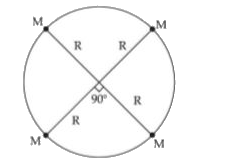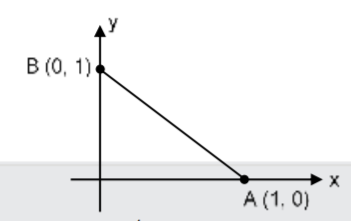A particle of mass m moves from A to C under the action of force →F=2xyˆi+y2ˆj , along different paths as shown in figure.

Force is conservative in nature.
Work done by force is 83 Joule when particle moves along path ABC
Force is non-conservative in nature and work done along path AC is 1 Joule
Work done along path ADC is 145 Joule.
The correct Answer is:C
Step by step video, text & image solution for A particle of mass m moves from A to C under the action of force vecF = 2xyhati + y^2 hatj , along different paths as shown in figure. by Physics experts to help you in doubts & scoring excellent marks in Class 12 exams.
Updated on:21/07/2023Topper's Solved these Questions
- KINEMATICSBook:FIITJEEChapter:KINEMATICSExercise:SECTION (II) : (SUBJECTIVE )
Explore 33 Videos
- KINEMATICSBook:FIITJEEChapter:KINEMATICSExercise:SECTION(II) : MCQ ( SINGLE CORRECT)
Explore 47 Videos
- KINEMATICSBook:FIITJEEChapter:KINEMATICSExercise:NUMERICAL BASED QUESTIONS
Explore 3 Videos
- HEAT AND TEMPERATUREBook:FIITJEEChapter:HEAT AND TEMPERATUREExercise:NUMERICAL BASES QUESTIONS
Explore 1 Video
- LAWS OF MOTIONBook:FIITJEEChapter:LAWS OF MOTIONExercise:COMPREHENSION-III
Explore 2 Videos
Similar Questions
Four particles each of mass M, move along a circle of radius R under the action of their mutual gravitational attraction as shown in figure. The speed of each particle is :

View SolutionA particle of mass 2kg is moving of a straight line under the actin force F=(8−2x)N. It is released at rest from x=6m.
a. Is the particle moving simple hormonically.
b. Find the equilibrium position of the particle.
c. Write the equation of motion of the particle.
d. Find the time period of SHM.
View Solution
Knowledge Check
A particle of mass m moves from A to C under the action of force →F=2xyˆi+y2ˆj , along different paths as shown in figure.
 AForce is conservative in nature.BWork done by force is 83 Joule when particle moves along path ABCCForce is non-conservative in nature and work done along path AC is 1 JouleDWork done along path ADC is 145 Joule.
AForce is conservative in nature.BWork done by force is 83 Joule when particle moves along path ABCCForce is non-conservative in nature and work done along path AC is 1 JouleDWork done along path ADC is 145 Joule.A particle of mass m moves from rest under the action of a constant force F which acts for two seconds. The maximum power attained is
A2FmBF2mC2FmD2F2mA body of mass 1 kg begins to move under the action of a time dependent force →F=(2tˆi+3t2ˆj)N, where ˆi and ˆj are unit vectors along x and y axis. What power will be developed by the force at the time?
A(2t3+3t4)WB(2t3+3t5)WC(2t2+3t3)WD(2t2+4t4)W
A particle moves under the action of a force F=20ˆi+15ˆj along a straight line 3y+αx=5, where, α is a constant. If the work done by the force F is zero the value of α is .
View SolutionA particle moves from point P(1,2,3) to (2,1,4) under the action of a constant force F=(2ˆi+ˆj+ˆk)N. Work done by the force is
View SolutionA particle of mass m moves in a circular path of radius r, under the action of force which delivers it constant power p and increases its speed. The angular acceleration of particle at time (t) is proportional
View SolutionParticle moves from point A to point B along the line shown in figure under the action of force. evcF=−xˆi+yˆj. Determine the work done on the particle by →F in moving the particle from point A to point B.

View SolutionA particle is moved from (0,0) to (a, a) under a force →F=(3ˆi+4ˆj) from two paths. Path 1 is OP and path 2 is OQP. Let W and W be the work done by this force in these two paths.Then

View Solution